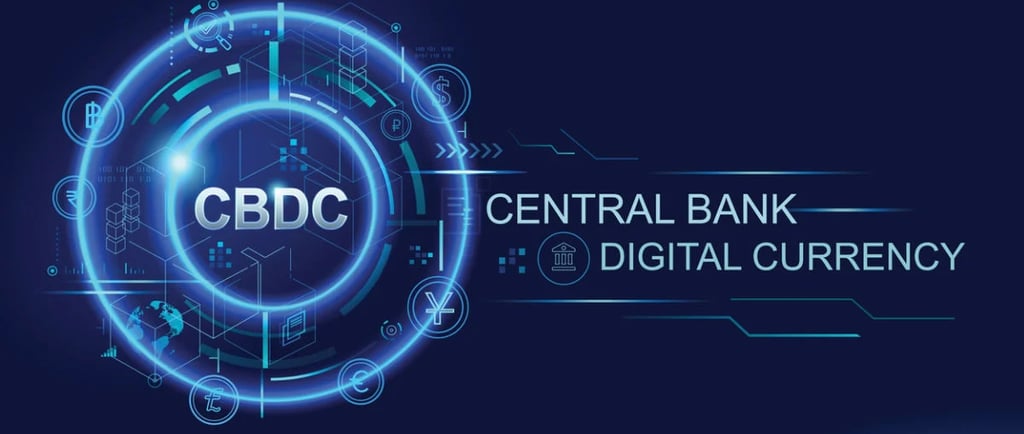items chosen one by one so you have the best option and save money on amazon (Links in articles)
The Rise of CBDCs: Will the Digital Dollar Kill Bitcoin?
As central banks around the world race to launch their own digital currencies, the question arises: Are Central Bank Digital Currencies (CBDCs) a threat to Bitcoin and the decentralized crypto movement? With the U.S. Digital Dollar, China's e-CNY, and Europe's Digital Euro gaining momentum, many wonder if Bitcoin’s role as digital money is in jeopardy. In this article, we explore the rise of CBDCs, how they differ from cryptocurrencies like Bitcoin, and what their impact might be on the future of decentralized finance.
5/22/20252 min leer


What Are CBDCs?
CBDCs are digital versions of national fiat currencies issued and regulated by central banks. Unlike Bitcoin, which is decentralized and operates independently of any government, CBDCs are centralized and controlled by monetary authorities.
🌐 Examples of CBDCs:
Digital Dollar (USA) – In pilot phases with regulated institutions
e-CNY (China) – Already in public trials with millions of users
Digital Euro (EU) – Under development by the European Central Bank
Amazon TECH Deals: https://amzn.to/4j8drcF
CBDCs are designed to function as digital cash—fast, traceable, and efficient. Bitcoin, on the other hand, was born out of a desire to escape government control and inflation.
Why Governments Are Launching CBDCs
Governments see CBDCs as a way to:
Modernize payment systems
Compete with stablecoins and cryptocurrencies
Improve financial inclusion
Increase control over monetary policy and taxation
For regulators, the idea of programmable money offers total visibility over transactions, and even the ability to restrict, tax, or reverse payments.
Is the Digital Dollar a Threat to Bitcoin?
In theory, CBDCs and Bitcoin serve different purposes. However, CBDCs could compete with Bitcoin on convenience, especially for people who currently use crypto for simple transactions or remittances.
⚔️ Potential Threats:
Regulation that favors CBDCs while restricting private cryptos
Public adoption driven by ease of use and integration with banks
Confusion between centralized digital currencies and decentralized cryptos
🛡️ Why Bitcoin Still Stands Strong:
Scarcity: Bitcoin’s 21M cap makes it a hedge against inflation
Independence: No government control or intervention
Global acceptance: Used across borders, independent of any state
The Role of Bitcoin in a CBDC World
As CBDCs become more common, Bitcoin may become even more valuable as the last bastion of monetary freedom. In a future where governments can control every transaction, Bitcoin offers:
Censorship resistance
Privacy
Sovereign ownership of assets
CBDCs might actually accelerate the adoption of Bitcoin by raising awareness about the downsides of total centralization.
What This Means for Crypto Investors
If you’re holding Bitcoin, here’s what to expect in the coming years:
Increased regulatory scrutiny – Governments may tighten rules on non-CBDC cryptos.
More CBDC vs Bitcoin debates – Media and policymakers may push narratives of Bitcoin being “obsolete.”
Opportunities for growth – As inflation, privacy concerns, and global debt rise, Bitcoin’s value proposition gets stronger.
Amazon TECH Deals: https://amzn.to/4j8drcF
Tools to Stay in Control of Your Crypto
As CBDCs emerge, it’s more important than ever to have self-custody tools to protect your crypto from central oversight. We recommend a cold wallet to store your Bitcoin securely and offline.
🔐 Recommended Product:
Ledger Nano X Cold Wallet
Buy on Amazon
🔚 Final Thoughts
CBDCs are coming—and fast. But rather than killing Bitcoin, they may help highlight the very features that make Bitcoin valuable: decentralization, freedom, and scarcity. In a world where financial systems become programmable and traceable, Bitcoin stands as a decentralized alternative and a lifeline for financial sovereignty.